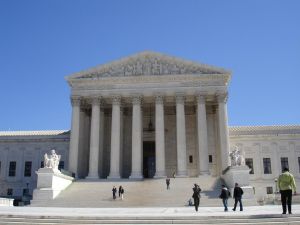 More than a year ago the Maryland Court of Appeals threw out Alonzo King’s rape conviction after ruling that police had illegally seized his DNA sample. Mr. King was arrested on an unrelated assault charge in 2009 and his DNA was collected under authority of a state law, which allowed cops to collect such samples from anyone arrested for a serious offense. This sample was fed into an FBI cold case database several months later and it matched an unidentified sample taken from the scene of a 2003 rape. Arrest and prosecution followed soon thereafter, and Mr. King suffered the same fate that most defendants do when trying to fight a case with inclulpatory DNA evidence, as he was found guilty and later sentenced to life in prison. Shortly after the Court of Appeals vacated King’s guilty plea the United States Supreme Court agreed to hear the case on a writ of certiorari. During the past year Mr. King, and to a lesser extent state law enforcement officers, Governor O’Malley, Attorney General Gansler, and anyone with direct or indirect concerns about our civil liberties have been on edge waiting to hear from the Court, and as of this week the wait is over.
More than a year ago the Maryland Court of Appeals threw out Alonzo King’s rape conviction after ruling that police had illegally seized his DNA sample. Mr. King was arrested on an unrelated assault charge in 2009 and his DNA was collected under authority of a state law, which allowed cops to collect such samples from anyone arrested for a serious offense. This sample was fed into an FBI cold case database several months later and it matched an unidentified sample taken from the scene of a 2003 rape. Arrest and prosecution followed soon thereafter, and Mr. King suffered the same fate that most defendants do when trying to fight a case with inclulpatory DNA evidence, as he was found guilty and later sentenced to life in prison. Shortly after the Court of Appeals vacated King’s guilty plea the United States Supreme Court agreed to hear the case on a writ of certiorari. During the past year Mr. King, and to a lesser extent state law enforcement officers, Governor O’Malley, Attorney General Gansler, and anyone with direct or indirect concerns about our civil liberties have been on edge waiting to hear from the Court, and as of this week the wait is over.
In a five to four decision the Supreme Court ruled that the Maryland DNA statute does not violate our Fourth Amendment rights, and law enforcement officials are free to sample the DNA of anyone arrested for a serious crime. The majority opined that an arrestee’s expectation of privacy is not offended by the minor intrusion of a brief swab of his cheeks, and by contrast the government has a significant interest in identifying the arrestee. The government, according to majority, must be able to accurately identify the arrestee so that the proper name can be attached to his charges, and also so the criminal justice system can make a fully informed decision about the arrestee’s pretrial custody status, i.e. the amount of his bail. The majority then compared DNA sampling to photographing, and the universally accepted, although never by Supreme Court opinion, practice of fingerprinting. The four dissenting Justices deferred to Justice Scalia to pen the dissent, which explained and discarded the majority’s 28-page opinion in 18 pages so brilliant that it was actually easy reading. Needless to say if you don’t have time to read both, start your reading after the words “it is so ordered”.
Continue reading →
 Criminal Defense Lawyer Blog
Criminal Defense Lawyer Blog


 Each year during the summer, the Maryland State Police releases its uniform crime report for the state of Maryland. The crime report uses data collected from every police jurisdiction in all 24 Maryland counties, but only factors in reported crimes in the report. The Maryland State Police defines reported crimes as actual incidents reported to police by victims, witnesses, and other sources used by law enforcement. Complaints of crime that law enforcement deem unfounded are not included in the reported crimes data. The annual uniform crime report is by no means a complete study of all crime in Maryland. In fact, the report only includes eight umbrella crimes in two separate categories, which are violent crimes and property crimes. A specific crime that does not fit into one of the umbrella crimes is not included in the report. Thus many of the most common crimes in Maryland such as DUI, drug possession, and drug sale are not included. In sum, the annual report is not a study of how many people are breaking the law in Maryland each year. Rather, the report analyzes the crimes that that have the greatest impact on citizens, and gauges how safe we really are throughout Maryland.
Each year during the summer, the Maryland State Police releases its uniform crime report for the state of Maryland. The crime report uses data collected from every police jurisdiction in all 24 Maryland counties, but only factors in reported crimes in the report. The Maryland State Police defines reported crimes as actual incidents reported to police by victims, witnesses, and other sources used by law enforcement. Complaints of crime that law enforcement deem unfounded are not included in the reported crimes data. The annual uniform crime report is by no means a complete study of all crime in Maryland. In fact, the report only includes eight umbrella crimes in two separate categories, which are violent crimes and property crimes. A specific crime that does not fit into one of the umbrella crimes is not included in the report. Thus many of the most common crimes in Maryland such as DUI, drug possession, and drug sale are not included. In sum, the annual report is not a study of how many people are breaking the law in Maryland each year. Rather, the report analyzes the crimes that that have the greatest impact on citizens, and gauges how safe we really are throughout Maryland. The United States Supreme Court will temporarily allow Maryland law enforcement agencies to resume their post arrest DNA testing policies according to an order signed by chief justice John Roberts. The DNA testing policies allow all Maryland law enforcement agencies to take DNA samples of suspects arrested for violent crimes such as robbery, assault, rape, and homicide. The law also allows police to take DNA from a suspect that is arrested for burglary. Although burglary is not a violent crime, it is a crime that is often only solved when forensic evidence such as DNA or latent fingerprints is recovered from the crime scene. Maryland police agencies are not allowed to take DNA samples upon arrest of suspects that are incarcerated for common non-violent crimes such as DUI, possession of marijuana, and drug distribution.
The United States Supreme Court will temporarily allow Maryland law enforcement agencies to resume their post arrest DNA testing policies according to an order signed by chief justice John Roberts. The DNA testing policies allow all Maryland law enforcement agencies to take DNA samples of suspects arrested for violent crimes such as robbery, assault, rape, and homicide. The law also allows police to take DNA from a suspect that is arrested for burglary. Although burglary is not a violent crime, it is a crime that is often only solved when forensic evidence such as DNA or latent fingerprints is recovered from the crime scene. Maryland police agencies are not allowed to take DNA samples upon arrest of suspects that are incarcerated for common non-violent crimes such as DUI, possession of marijuana, and drug distribution. A Baltimore City police officer was recently charged with assault after being involved in an altercation in Harford County, Maryland. The exact facts surrounding the altercation are in dispute, but the Baltimore police officer certainly has an interesting explanation for how he became involved in the assault. The criminal charging document alleges that the 10 year Baltimore police veteran, who was off duty at the time, approached a parked vehicle with two occupants seated inside. The police officer was apparently yelling at the occupants to stop dealing drugs, and approached the car in a threatening manner despite not seeing any actual drug transaction taking place.
A Baltimore City police officer was recently charged with assault after being involved in an altercation in Harford County, Maryland. The exact facts surrounding the altercation are in dispute, but the Baltimore police officer certainly has an interesting explanation for how he became involved in the assault. The criminal charging document alleges that the 10 year Baltimore police veteran, who was off duty at the time, approached a parked vehicle with two occupants seated inside. The police officer was apparently yelling at the occupants to stop dealing drugs, and approached the car in a threatening manner despite not seeing any actual drug transaction taking place.  Road rage and aggressive driving incidents in Maryland have become common in the last decade, and law makers have been forced to address the issue, but rarely does a road range incident make news headlines. Unfortunately a recent dangerous road rage incident appeared in the news just last weekend. The Maryland state police has reported that a road rage incident on interstate 295 in Baltimore has resulted in a pair of arrests and multiple serious injuries. Police arrested one Maryland man who was the driver of the main vehicle involved in the road rage incident for DUI, assault, and destruction of property. The passenger, another Maryland man, was also arrested and charged with assault and malicious destruction of property.
Road rage and aggressive driving incidents in Maryland have become common in the last decade, and law makers have been forced to address the issue, but rarely does a road range incident make news headlines. Unfortunately a recent dangerous road rage incident appeared in the news just last weekend. The Maryland state police has reported that a road rage incident on interstate 295 in Baltimore has resulted in a pair of arrests and multiple serious injuries. Police arrested one Maryland man who was the driver of the main vehicle involved in the road rage incident for DUI, assault, and destruction of property. The passenger, another Maryland man, was also arrested and charged with assault and malicious destruction of property. On Sunday night in Washington D.C., Nationals 19 year old baseball phenom Bryce Harper came up to bat in the bottom of the first inning. Veteran Phllies pitcher, Cole Hamels then proceeded to throw his first pitch directly at the lower back of Harper. Harper bent over in obvious pain for a few seconds, trotted off to first base, and then scored the first run of the game a few pitches later. After the game, the veteran pitcher admitted that he purposely threw the pitch in Harper’s direction, and fully intended to hit him. Hamels stated that throwing at Harper was his way of welcoming the rookie sensation to the major leagues. The commissioner of baseball however was not impressed with Hamels’ actions nor his honesty, and suspended the pitcher for 5 games.
On Sunday night in Washington D.C., Nationals 19 year old baseball phenom Bryce Harper came up to bat in the bottom of the first inning. Veteran Phllies pitcher, Cole Hamels then proceeded to throw his first pitch directly at the lower back of Harper. Harper bent over in obvious pain for a few seconds, trotted off to first base, and then scored the first run of the game a few pitches later. After the game, the veteran pitcher admitted that he purposely threw the pitch in Harper’s direction, and fully intended to hit him. Hamels stated that throwing at Harper was his way of welcoming the rookie sensation to the major leagues. The commissioner of baseball however was not impressed with Hamels’ actions nor his honesty, and suspended the pitcher for 5 games.